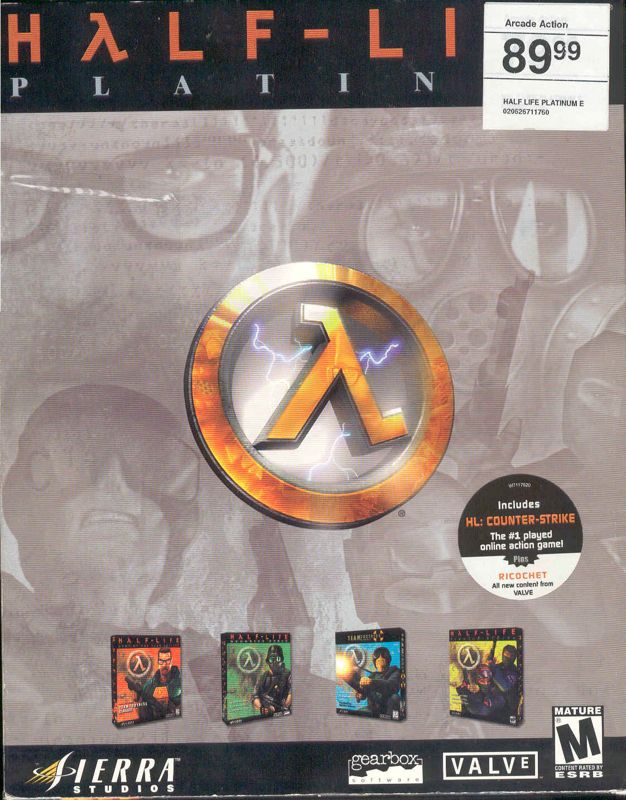Retro Replay Review
Gameplay
Half-Life: Platinum delivers a rich tapestry of gameplay experiences, seamlessly weaving together the tense single-player campaigns of Half-Life: Game of the Year Edition and Opposing Force with the frenetic multiplayer modes of Counter-Strike and Team Fortress Classic. From the moment you don Gordon Freeman’s HEV suit to battle alien hordes in Black Mesa, the core mechanics feel tight and responsive. Gravity Gun puzzles, precise shooting, and exploration-driven progression keep each encounter fresh and rewarding.
(HEY YOU!! We hope you enjoy! We try not to run ads. So basically, this is a very expensive hobby running this site. Please consider joining us for updates, forums, and more. Network w/ us to make some cash or friends while retro gaming, and you can win some free retro games for posting. Okay, carry on 👍)
Opposing Force shifts the perspective entirely, placing you in the boots of U.S. Marine Adrian Shephard. The altered arsenal, new enemy types, and revised level layouts offer veterans a fresh challenge, while newcomers gain insight into the broader Half-Life universe. The pacing excels at alternating between claustrophobic underground tunnels and open combat arenas, ensuring that no two firefights feel the same.
Counter-Strike and Team Fortress Classic expand the package’s scope by delivering foundational multiplayer environments that have influenced countless modern shooters. Counter-Strike’s bomb-plant and hostage-rescue objectives demand teamwork, strategy, and precise aim, fostering a competitive landscape that remains engaging decades later. Meanwhile, Team Fortress Classic introduces a class-based system with unique roles—medic, sniper, and demolition man among them—encouraging players to adapt their tactics on the fly.
Across all four titles, the game’s physics engine underpins satisfying interactions, whether you’re hurling explosive barrels, punching through barricades, or skillfully maneuvering through chokepoints. This compilation is not merely a nostalgia trip but a demonstration of foundational shooter design that paved the way for modern innovations.
Graphics
Despite being rooted in the GoldSrc engine of the late ’90s, Half-Life: Platinum retains a distinct visual identity that holds up surprisingly well. The textures and environmental details may appear dated next to contemporary titles, but updated resolution support and community-made texture packs breathe new life into iconic locations. The dim corridors of Black Mesa still evoke a looming sense of dread, while outdoor sequences showcase dramatic lighting that accentuates the game’s sci-fi atmosphere.
Opposing Force and the multiplayer modes carry forward this aesthetic with minimal visual disparity, ensuring a cohesive look across all four games. Character models are angular by modern standards, yet each enemy design—Vortigaunts, headcrabs, grunts—remains instantly recognizable and exudes personality through animations and color schemes. The weapon models, though simplistic, deliver satisfying muzzle flashes and impact effects that reinforce every shot’s weight.
Counter-Strike and Team Fortress Classic benefit from the same engine enhancements, retaining clear sightlines and distinguishable map layouts crucial for competitive play. Map designs like de_dust and 2fort maintain a classic charm while accommodating high-resolution displays without compromising performance. Even on mid-range hardware, the compilation runs smoothly, offering stable frame rates that are vital for multiplayer precision.
Overall, graphical fidelity may not rival modern AAA blockbusters, but Half-Life: Platinum’s visuals contribute significantly to its enduring appeal. The balance of mood-setting environments, character expressiveness, and responsive design holds up for both nostalgic veterans and curious newcomers alike.
Story
At its core, Half-Life: Platinum’s narrative strength lies in immersive worldbuilding and environmental storytelling. Gordon Freeman’s silent protagonist approach allows players to project themselves into the chaos of the Black Mesa Research Facility, where every overheard conversation and scattered document deepens the sense of confinement and impending catastrophe. The seamless transition from research labs to alien-infested corridors keeps the stakes high and curiosity piqued.
Opposing Force enriches the lore by introducing new characters, motivations, and plot threads. As Adrian Shephard, players witness the military’s attempt to contain the resonance cascade from an insider’s perspective, raising questions about government agendas and ethical boundaries. The expanded storyline offers fresh revelations while complementing Freeman’s journey, creating a more nuanced understanding of the Half-Life universe.
Multiplayer modes, while not narrative-driven, thrive on emergent storytelling through player interactions. Counter-Strike matches evolve into tense thrillers, where a single defuse or well-placed grenade can become a memorable moment passed among friends. Team Fortress Classic’s class battles form impromptu tales of heroism and teamwork—medic revives, sniper headshots, or demolition charges that swing the momentum create unforgettable anecdotes.
Together, these story elements—structured campaigns and player-driven narratives—showcase a versatile storytelling palette. Half-Life: Platinum doesn’t just present a fixed plot but fosters a living world shaped by both scripted events and communal play.
Overall Experience
Half-Life: Platinum stands as a testament to the enduring power of well-crafted game design. The compilation offers exceptional value, packing four genre-defining experiences into a single package. Whether you’re diving into the suspenseful corridors of Black Mesa, exploring a marine’s perspective in Opposing Force, or battling in online arenas, there’s a depth and polish that few collections can match.
The seamless integration of single-player and multiplayer modes ensures that players can shift gears between narrative immersion and competitive excitement without leaving the compilation. This synergy fosters broad replayability: revisiting classic maps, discovering community mods, or simply reliving the original campaigns in higher resolutions. A vibrant modding community further expands the experience, adding new levels, visual overhauls, and gameplay tweaks that keep the package relevant.
On the technical front, the compilation’s stability and compatibility with modern systems make it accessible to a wide audience. Steam achievements, workshop support, and built-in matchmaking rejuvenate the multiplayer scene, connecting longtime fans and new players alike. The soundtrack and sound design—ambient hums, distant creature shrieks, weapon blasts—complete the immersion.
Ultimately, Half-Life: Platinum isn’t just a historical artifact; it’s a living, breathing collection that offers both a look back at gaming’s formative years and a compelling playthrough for today’s audiences. Whether you’re seeking a gripping solo adventure or engaging team battles, this compilation delivers on every front, making it a must-have for fans of first-person shooters and gaming history enthusiasts alike.
 Retro Replay Retro Replay gaming reviews, news, emulation, geek stuff and more!
Retro Replay Retro Replay gaming reviews, news, emulation, geek stuff and more!




Reviews
There are no reviews yet.